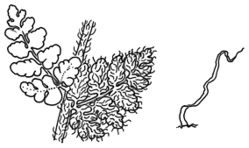Common name: Woolly Cloak-fern, Woolly Cloak Fern
Cheilanthes lasiophylla Pic.Serm. APNI* 
Description: Rhizome short-creeping, densely covered with lanceolate, entire scales.
Fronds crowded, 6–24 cm high, < 3 cm wide; stipe red-brown to black, shiny, densely covered with white or golden-brown scales; lamina narrow-lanceolate, 2-pinnate, upper surface ± densely hairy with long slender branched whitish hairs, lower surface with scales and slender branched whitish hairs; ultimate segments sessile, 2–5 mm long and 2 mm wide, margins lobed or entire.
Sori becoming confluent and continuous around the margins of the segments.
Distribution and occurrence: Occurs across much of Australia, and New South Wales, but is rare, or absent from the eastern side of the Great Dividing Range in our state. On rocky outcrops and hills in inland arid regions.
NSW subdivisions: NWS, CWS, NWP, SWP, NFWP
Other Australian states: Qld Vic. W.A. S.A. N.T.
One of the distinctive characters of Cheilanthes lasiophylla is the long, branched hairs, which occur on the upper and lower suface of the lamina, and on the stipe and rachis. Establishing whether or not the hairs branch is challenging, because they are often close-set, overlapping, and refract light, all of which obscure hair form. Definitive assessment of hair morphology and branching may, sometimes, only be possible when the hairs have been removed and slide mounted for examination on a compound microscope. In any event, the hairs should always be removed for inspection. Placing a clump of removed hairs in a few drops of water, and stirring them around or smearing them gently on a surface may sufficiently isolate individual hairs such that their form can be ascertained with a decent hand lens.
Text by Peter G. Wilson based on T.C. Chambers & P.A. Farrant (1998), with modification and updates by Matt A.M. Renner (9 April 2021).
Taxon concept:
APNI* Provides a link to the Australian Plant Name Index (hosted by the Australian National Botanic Gardens) for comprehensive bibliographic data
***The AVH map option provides a detailed interactive Australia wide distribution map drawn from collections held by all major Australian herbaria participating in the Australian Virtual Herbarium project.
|


